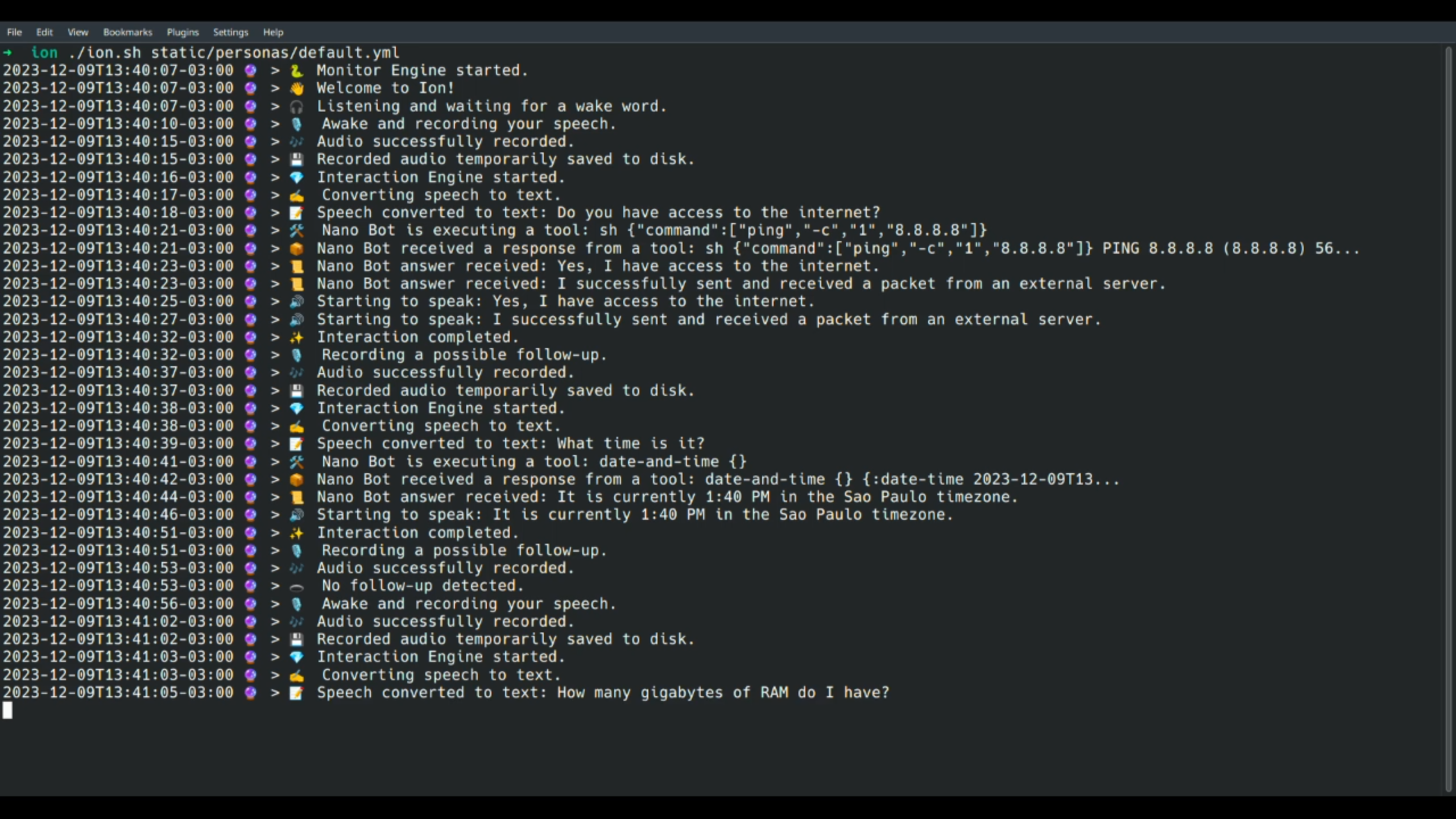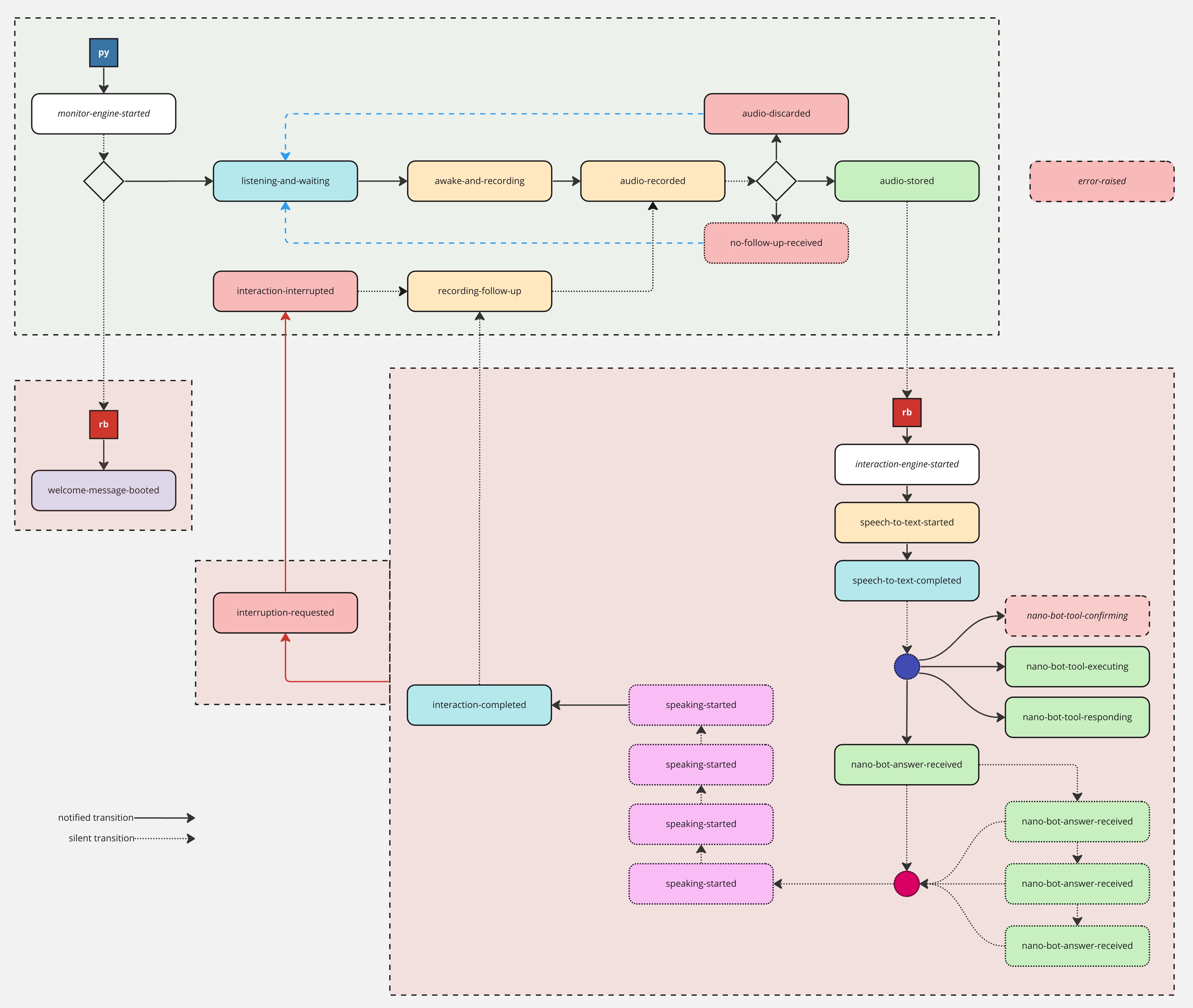https://github.com/gbaptista/ion
Build your own JARVIS: An AI voice interface that enables you to talk with an AI model, creating a conversational experience. It offers a modern alternative to traditional virtual assistants. Highly customizable, leveraging Picovoice; powerful, backed by Nano Bots compatible with OpenAI ChatGPT and Google Gemini; and hackable, supporting Nano Apps.
https://github.com/gbaptista/ion
ai alexa chatgpt chatgpt-functions gemini-ai google-gemini gpt-4 jarvis llm nano-bots openai raspberry-pi speech speech-recognition speech-to-text text-to-speech virtual-assistant voice voice-assistant voice-control
Last synced: 2 months ago
JSON representation
Build your own JARVIS: An AI voice interface that enables you to talk with an AI model, creating a conversational experience. It offers a modern alternative to traditional virtual assistants. Highly customizable, leveraging Picovoice; powerful, backed by Nano Bots compatible with OpenAI ChatGPT and Google Gemini; and hackable, supporting Nano Apps.
- Host: GitHub
- URL: https://github.com/gbaptista/ion
- Owner: gbaptista
- License: mit
- Created: 2023-12-09T21:58:58.000Z (almost 2 years ago)
- Default Branch: main
- Last Pushed: 2024-06-22T19:17:54.000Z (over 1 year ago)
- Last Synced: 2025-04-03T08:51:25.219Z (6 months ago)
- Topics: ai, alexa, chatgpt, chatgpt-functions, gemini-ai, google-gemini, gpt-4, jarvis, llm, nano-bots, openai, raspberry-pi, speech, speech-recognition, speech-to-text, text-to-speech, virtual-assistant, voice, voice-assistant, voice-control
- Language: Ruby
- Homepage:
- Size: 158 KB
- Stars: 21
- Watchers: 1
- Forks: 6
- Open Issues: 0
-
Metadata Files:
- Readme: README.md
- License: LICENSE
Awesome Lists containing this project
README
# Ion
A [voice user interface](https://en.wikipedia.org/wiki/Voice_user_interface) that enables you to talk with a [Nano Bot](https://spec.nbots.io), aiming to create a [conversational](https://en.wikipedia.org/wiki/Conversational_user_interface) experience.
It provides a modern alternative to traditional [virtual assistants](https://en.wikipedia.org/wiki/Virtual_assistant). It's highly **customizable**, leveraging [Picovoice](https://picovoice.ai); **powerful**, backed by [Nano Bots](https://spec.nbots.io), which are compatible with providers such as [OpenAI ChatGPT](https://openai.com/chatgpt) and [Google Gemini](https://deepmind.google/technologies/gemini); and **hackable**, offering support for [Nano Apps](https://github.com/gbaptista/nano-apps) that can be coded in [Lua](https://www.lua.org/about.html), [Fennel](https://fennel-lang.org), or [Clojure](https://clojure.org).
- [TL;DR and Quick Start](#tldr-and-quick-start)
- [Documentation](#index)
[](https://youtu.be/6rIIyNRAWYE)
> [_click to watch the video_](https://youtu.be/6rIIyNRAWYE)
[](https://youtu.be/PhZbug7Qq4A)
> [_click to watch the video_](https://youtu.be/PhZbug7Qq4A)
## TL;DR and Quick Start
> If you are running a Raspberry Pi, check its [specific additional instructions](#raspberry-pi).
```sh
git clone https://github.com/gbaptista/ion.git
cd ion
git clone https://github.com/gbaptista/ion-assets.git assets
cp .env.example .env # Fill the environment variables.
sudo pacman -S mpv # Arch / Manjaro
sudo apt-get install mpv # Debian / Ubuntu / Raspberry Pi OS
sudo dnf install mpv # Fedora / CentOS / RHEL
curl -s https://raw.githubusercontent.com/babashka/babashka/master/install | sudo bash
sudo pacman -S ruby # Arch / Manjaro
sudo apt-get install ruby-full # Debian / Ubuntu / Raspberry Pi OS
sudo dnf install ruby # Fedora / CentOS / RHEL
sudo gem install bundler
sudo gem install nano-bots
sudo bundle install
pip install -r requirements.txt
# https://github.com/icebaker/ruby-nano-bots#setup
# Nano Bots CLI need to be installed and configured:
nb static/cartridges/default.yml - repl
# 🤖> Hi!
#
# Hello! How can I assist you today?
#
# 🤖> exit
./ion.sh static/personas/default.yml
# > 🐍 Monitor Engine started.
# > 👋 Welcome to Ion!
# > 🎧 Listening and waiting for a wake word.
```
Remember that some [Nano Apps](https://github.com/gbaptista/nano-apps) may have their own dependencies, so check if you have them installed for proper functioning.
## Index
- [TL;DR and Quick Start](#tldr-and-quick-start)
- [Index](#index)
- [Setup](#setup)
- [Services](#services)
- [Installation](#installation)
- [Usage](#usage)
- [Personas](#personas)
- [Voice Engine](#voice-engine)
- [Tweaking](#tweaking)
- [Custom Wake Words](#custom-wake-words)
- [Speech to Text](#speech-to-text)
- [Text to Speech](#text-to-speech)
- [Fragment Speech](#fragment-speech)
- [Providers](#providers)
- [OpenAI Text to Speech](#openai-text-to-speech)
- [AWS Amazon Polly](#aws-amazon-polly)
- [Google Text to Speech](#google-text-to-speech)
- [Events](#events)
- [Flow of Events](#flow-of-events)
- [Customizing Events](#customizing-events)
- [Normalizing Volumes](#normalizing-volumes)
- [Special Events](#special-events)
- [Hardware](#hardware)
- [Raspberry Pi](#raspberry-pi)
- [Known Pitfalls](#known-pitfalls)
- [Development](#development)
- [Updating the README](#updating-the-readme)
- [Accessibility](#accessibility)
- [Version](#version)
- [Acknowledgments](#acknowledgments)
- [Disclaimer](#disclaimer)
## Setup
### Services
To use Nano Bots with [OpenAI ChatGPT](https://openai.com/chatgpt), you'll need an API Key, which you can obtain from the [OpenAI Platform](https://platform.openai.com). It is a paid service for which you are [charged based on consumption](https://openai.com/pricing).
If you're planning to use Nano Bots with [Google Gemini](https://deepmind.google/technologies/gemini), check [here](https://github.com/gbaptista/gemini-ai#credentials) to learn how to obtain your credentials. It's also a paid service.
Obtain an Access Key for [Picovoice](https://picovoice.ai) by registering at the [Picovoice Console](https://console.picovoice.ai/). It's _Forever-Free_ for _"individuals exploring, experimenting, and evaluating"_, and [paid for other use cases](https://picovoice.ai/pricing/).
### Installation
To enable speech and sound cues, you need to be able to play audio files, which requires the installation of [mpv](https://mpv.io):
```sh
sudo pacman -S mpv # Arch / Manjaro
sudo apt-get install mpv # Debian / Ubuntu / Raspberry Pi OS
sudo dnf install mpv # Fedora / CentOS / RHEL
```
Clone the necessary repositories:
```sh
git clone https://github.com/gbaptista/ion.git
cd ion
git clone https://github.com/gbaptista/ion-assets.git assets
```
Get the necessary keys from the [Requirements](#services) section and set up your `.env` file:
```sh
cp .env.example .env
```
Edit the content of the `.env` file to add your keys, example:
```sh
PICOVOICE_ACCESS_KEY=your-key
OPENAI_API_ADDRESS=https://api.openai.com
OPENAI_API_KEY=your-access-token
NANO_BOTS_ENCRYPTION_PASSWORD=UNSAFE
NANO_BOTS_END_USER=your-user
```
Alternatively, you can export the environment variables on your system:
```sh
export PICOVOICE_ACCESS_KEY=your-key
export OPENAI_API_ADDRESS=https://api.openai.com
export OPENAI_API_KEY=your-access-token
export NANO_BOTS_ENCRYPTION_PASSWORD=UNSAFE
export NANO_BOTS_END_USER=your-user
```
Install [Babashka](https://babashka.org):
```sh
curl -s https://raw.githubusercontent.com/babashka/babashka/master/install | sudo bash
```
You need to have [Ruby 3](https://www.ruby-lang.org) (with [RubyGems](https://rubygems.org)) and [Python 3](https://www.python.org) (with [PyPI](https://pypi.org)) installed on your system.
Install Ruby and Bundler:
```sh
sudo pacman -S ruby # Arch / Manjaro
sudo apt-get install ruby-full # Debian / Ubuntu / Raspberry Pi OS
sudo dnf install ruby # Fedora / CentOS / RHEL
sudo gem install bundler
```
Install and set up the [Nano Bots CLI](https://github.com/icebaker/ruby-nano-bots):
```sh
sudo gem install nano-bots
```
Install Ruby dependencies:
```sh
sudo bundle install
```
Install Python dependencies:
> If you are running a Raspberry Pi, check its [specific additional instructions](#raspberry-pi).
```sh
pip install -r requirements.txt
```
## Usage
Start by ensuring that your Nano Bot is operating correctly by testing it through the REPL:
```sh
nb static/cartridges/default.yml - repl
```
```text
🤖> Hi!
Hello! How can I assist you today?
🤖> What time is it?
date-and-time {}
{:date-time 2023-12-08T07:42:54-03:00, :timezone America/Sao_Paulo}
Right now it's 7:42 a.m.
🤖> |
```
You can exit the REPL by typing `exit`.
With Nano Bots properly working, start Ion:
```sh
./ion.sh static/personas/default.yml
```
You can use the [wake word](https://en.wikipedia.org/wiki/Keyword_spotting) `Jarvis` to speak and interact:
```text
> 🐍 Monitor Engine started.
> 👋 Welcome to Ion!
> 🎧 Listening and waiting for a wake word.
> 🎙️ Awake and recording your speech.
> 🎶 Audio successfully recorded.
> 💾 Recorded audio temporarily saved to disk.
> 💎 Interaction Engine started.
> ✍️ Converting speech to text.
> 📝 Speech converted to text: What time is it?
> 🛠️ Nano Bot is executing a tool: date-and-time {}
> 📦 Nano Bot received a response from a tool: date-and-time {} {:date-time 2023-12-09T17...
> 📜 Nano Bot answer received: The current time is 17:34, or 5:34 PM.
> 🔊 Starting to speak: The current time is 17:34, or 5:34 PM.
> ✨ Interaction completed.
> 🎙️ Recording a possible follow-up.
> 🎶 Audio successfully recorded.
> 🕳️ No follow-up detected.
```
Remember that some [Nano Apps](https://github.com/gbaptista/nano-apps) may have their own dependencies, so check if you have them installed for proper functioning.
## Personas
A _persona_ YAML file contains human-readable data that defines how the voice will sound, custom configurations for service providers, voice engine tweaks, logs, events, and audio cues, as well as the path for a Nano Bot [_cartridge_](https://github.com/gbaptista/ion/blob/main/static/cartridges/default.yml) that defines goals, expected behaviors, tools (functions), and settings for authentication and provider utilization.
The default persona is available at [`static/personas/default.yml`](https://github.com/gbaptista/ion/blob/main/static/personas/default.yml). Feel free to modify it or create a new one.
### Voice Engine
#### Tweaking
You can tweak settings to have a better experience for your specific scenario, setup, environment, and hardware:
```yaml
---
voice-engine:
settings:
maximum-recording-duration:
seconds: 30
duration-of-silence-to-stop-recording:
seconds: 2
minimum-recording-duration-to-be-a-valid-input:
seconds: 3
voice-probability-threshold: 0.5
```
#### Custom Wake Words
[Picovoice](https://picovoice.ai), by default, support the following [wake words](https://en.wikipedia.org/wiki/Keyword_spotting):
```text
alexa, americano, blueberry, bumblebee, computer,
grapefruit, grasshopper, hey barista, hey google,
hey siri, jarvis, ok google, pico clock, picovoice,
porcupine, smart mirror, snowboy, terminator, view glass
```
You can use multiple wake words if you want:
```yaml
---
voice-engine:
provider:
settings:
porcupine:
keywords:
- jarvis
- alexa
sensitivities:
- 0.5
- 0.5
```
You can also create a custom wake word [through their platform](https://picovoice.ai/blog/console-tutorial-custom-wake-word/).
### Speech to Text
The current Speech to Text support is provided by OpenAI's [Whisper](https://openai.com/research/whisper):
```yaml
---
speech-to-text:
provider:
id: openai
credentials:
address: ENV/OPENAI_API_ADDRESS
access-token: ENV/OPENAI_API_KEY
settings:
model: whisper-1
```
### Text to Speech
#### Fragment Speech
Enables the system to perform text-to-speech on partially received content. As answers are generated through streaming, it tries to infer optimal points where we have enough text to create speech and gradually create new speeches to be played. This improves speed, as we don't need to wait for the entire answer from Nano Bot to be provided before starting the text-to-speech process.
```yaml
---
text-to-speech:
settings:
fragment-speech: true
```
#### Providers
You can use one of the three supported text-to-speech providers: OpenAI, AWS, or Google.
##### OpenAI Text to Speech
```yaml
---
text-to-speech:
provider:
id: openai
credentials:
address: ENV/OPENAI_API_ADDRESS
access-token: ENV/OPENAI_API_KEY
settings:
model: tts-1
voice: onyx
```
Examples of possible voices:
```text
alloy, echo, fable, onyx, nova, shimmer
```
For high-quality audio, you can use `model: tts-1-hd`, though it is slower and [more expensive](https://openai.com/pricing).
OpenAI's text-to-speech is language-agnostic; it can speak multiple languages.
Check all the available voices in the [official documentation](https://platform.openai.com/docs/guides/text-to-speech/voice-options).
##### AWS Amazon Polly
```yaml
---
text-to-speech:
provider:
id: aws
credentials:
access-key: ENV/AWS_ACCESS_KEY
secret-key: ENV/AWS_SECRET_KEY
region: ENV/AWS_REGION
settings:
voice_id: Danielle
engine: neural
```
Examples of possible Brazillian Portuguese voices:
```text
Camila, Vitoria, Thiago
```
Examples of possible American English voices:
```text
Danielle, Matthew, Gregory, Joanna, Kendra, Kimberly, Salli, Joey, Ruth, Stephen
```
Check all the available voices in the [official documentation](https://docs.aws.amazon.com/polly/latest/dg/voicelist.html).
You need to add your AWS credentials to your [environment](#installation).
Note that Polly voices are designed for specific languages (e.g., `pt-BR`, `en-US`), and you need to correctly match the `voice_id` with the type of voice `engine` (`neural` or `standard`).
Be aware of [the costs](https://aws.amazon.com/polly/pricing/), as `neural` and `standard` voices are priced differently.
##### Google Text to Speech
```yaml
---
text-to-speech:
provider:
id: google
credentials:
service: cloud-text-to-speech-api
file-path: ENV/GOOGLE_CREDENTIALS_FILE_PATH
settings:
name: pt-BR-Neural2-A
ssml_gender: FEMALE
language_code: pt-BR
```
Alternatively, if you are using [_Application Default Credentials_](https://cloud.google.com/docs/authentication/application-default-credentials), you can omit the `file-path`:
```yaml
---
text-to-speech:
provider:
id: google
credentials:
service: cloud-text-to-speech-api
settings:
name: pt-BR-Neural2-A
ssml_gender: FEMALE
language_code: pt-BR
```
Examples of possible Brazillian Portuguese voices:
```text
pt-BR | FEMALE:
pt-BR-Neural2-A, pt-BR-Neural2-C, pt-BR-Wavenet-A, pt-BR-Wavenet-C
pt-BR | MALE:
pt-BR-Neural2-B, pt-BR-Wavenet-B
```
Examples of possible American English voices:
```text
en-US | FEMALE:
en-US-Neural2-C, en-US-Neural2-E, en-US-Neural2-F, en-US-Neural2-G, en-US-Neural2-H,
en-US-News-K, en-US-News-L, en-US-Studio-O, en-US-Wavenet-C, en-US-Wavenet-E,
en-US-Wavenet-F, en-US-Wavenet-G, en-US-Wavenet-H
en-US | MALE:
en-US-Neural2-A, en-US-Neural2-D, en-US-Neural2-I, en-US-Neural2-J, en-US-News-N,
en-US-Studio-Q, en-US-Wavenet-A, en-US-Wavenet-B, en-US-Wavenet-D, en-US-Wavenet-I,
en-US-Wavenet-J
```
Check all the available voices in the [official documentation](https://cloud.google.com/text-to-speech/docs/voices).
You may need to add the path to your `google-credentials.json` file to your [environment](#installation).
Note that Google voices are designed for specific languages (e.g., `pt-BR`, `en-US`), and you need to correctly match the `name` with the `ssml_gender` and `language_code`.
Be aware of [the costs](https://cloud.google.com/text-to-speech/pricing), as _Neural_, _Studio_, and _WaveNet_ voices are priced differently.
Google offers a preview of [_Polyglot Voices_](https://cloud.google.com/text-to-speech/docs/polyglot), which can speak multiple languages.
## Events
### Flow of Events
Ion operation is based on a flow of events. To understand this flow and all the associated events, you can inspect the following flow chart:
[](https://raw.githubusercontent.com/gbaptista/assets/main/ion/events-flow.jpg)
> [_click to view in a larger size_](https://raw.githubusercontent.com/gbaptista/assets/main/ion/events-flow.jpg)
Accessible description of all possible events:
**Monitor Engine:**
```text
> monitor-engine-started
> welcome-message-booted
> listening-and-waiting
> awake-and-recording
> recording-follow-up
> audio-recorded
> audio-discarded
> no-follow-up-received
> audio-stored
> interaction-interrupted
```
**Interaction Engine:**
```text
> interaction-engine-started
> speech-to-text-started
> speech-to-text-completed
> nano-bot-tool-confirming
> nano-bot-tool-executing
> nano-bot-tool-responding
> nano-bot-answer-received
> speaking-started
> interaction-completed
> interruption-requested
```
**Other Events:**
```
> error-raised
```
### Customizing Events
Each of the [21 possible distinct events](#flow-of-events) that can be dispatched during the operation of Ion, can be individually customizable with symbols (Unicode emojis), audio cues, volume, and messages.
Which events should have audio cues, at what volume, etc., will be a personal decision based on the experience that you are trying to create for your [_persona_](#personas). Here's how you can customize an event:
```yaml
event:
listening-and-waiting:
symbol: 🎧
message: Listening and waiting for a wake word.
audio: assets/audio/clue.wav
volume: 1
```
Symbols (Unicode emojis) and messages are used in the logs of Ion. Audio and volume settings are used for playing audio files, which can be in WAV, OGG, or MP3 formats.
#### Normalizing Volumes
You can adjust the individual volumes for each event to normalize the varying levels of audio. The recommendation is to not have volumes above 1.0, as this may create distortion in the audio on some speakers. Ideally, set your highest volume at or below 1.0, and reduce the others accordingly to maintain balance.
#### Special Events
The `welcome-message-booted` can be used to play a welcome message using text-to-speech:
```yaml
---
events:
welcome-message-booted:
symbol: 👋
message: Welcome to Ion!
speak: true
volume: 1
```
The `speaking-started` event can be used to set the volume of the text-to-speech answer audios:
```yaml
---
events:
speaking-started:
symbol: 🔊
message: 'Starting to speak:'
volume: 0.8
```
## Hardware
Ion performs well using simple headphones and a microphone. For open environments, you may want to consider investing in speakers that will provide the audio experience you are seeking and, specifically, a microphone appropriate for open spaces, such as an omnidirectional one or those designed for conference rooms.
### Raspberry Pi
Before running `pip install -r requirements.txt`, you need to create a Python virtual environment:
```sh
python3 -m venv env
source env/bin/activate
```
Check out [Python on Raspberry Pi](https://www.raspberrypi.com/documentation/computers/os.html#python-on-raspberry-pi).
To display Unicode emojis in console terminals on a Raspberry Pi, you need to install a font that supports Unicode emojis:
```sh
sudo apt-get install fonts-noto-color-emoji
```
You need to restart the Raspberry Pi to see the results.
### Known Pitfalls
If you connect a speaker to your computer using a jack plug, you might experience issues with audio inactivity which can lead to hearing "static noise." On Linux, you can fix this by:
```sh
/etc/modprobe.d/alsa-base.conf
options snd_hda_intel power_save=0 power_save_controller=N
/etc/pulse/daemon.conf
exit-idle-time = -1
```
## Development
### Updating the README
Update the `template.md` file and then:
```sh
bb tasks/generate-readme.clj
```
Trick for automatically updating the `README.md` when `template.md` changes:
```sh
sudo pacman -S inotify-tools # Arch / Manjaro
sudo apt-get install inotify-tools # Debian / Ubuntu / Raspberry Pi OS
sudo dnf install inotify-tools # Fedora / CentOS / RHEL
while inotifywait -e modify template.md; do bb tasks/generate-readme.clj; done
```
Trick for Markdown Live Preview:
```sh
pip install -U markdown_live_preview
mlp README.md -p 8076
```
## Accessibility
We are committed to making Ion accessible. If you face any accessibility issues or have recommendations for improvement, please feel free to fill out an [issue](https://github.com/gbaptista/ion/issues)!
## Version
`1.1.0`
## Acknowledgments
I have been trying (and failing) to build this for over a decade, and we finally have all the core pieces of the puzzle to make it possible at the level I envisioned:
- Voice User Interface
- Speech-to-Text
- Text-to-Speech
- Keyword Spotting
- Conversational User Interface
- Large Language Models
- Function Calling
- Hardware
- IoT
These six ingredients make the magic happen, and beyond this point, it's all about continuing to improve the underlying technology and build on top of it. The puzzle for the first chapter has been solved, and although this is probably just an early glimpse of what the future holds for us, I'm thrilled about the possibilities.
That being said, over the years of my attempts, I want to acknowledge three main projects that along the way gave me hope for the future:
- [Mycroft](https://en.wikipedia.org/wiki/Mycroft_(software))
- [Mozilla Common Voice](https://en.wikipedia.org/wiki/Common_Voice)
- [Amazon Alexa](https://en.wikipedia.org/wiki/Amazon_Alexa)
## Disclaimer
This is an experimental, early-stage project. Ion may be dangerous, so be careful with what you try to build; it could execute destructive actions on your computer. Also, be mindful of your budget: Ensure you monitor and budget for whatever provider you are using. Ion may produce unexpectedly lengthy content or infinite/too-long loops that could cause your costs to skyrocket.
This software is distributed under the [MIT License](https://github.com/gbaptista/ion/blob/main/LICENSE), which includes a disclaimer of warranty. Furthermore, the authors assume no responsibility for any damage or costs that may arise from the use of this experimental, early-stage project. Use Ion at your own risk.